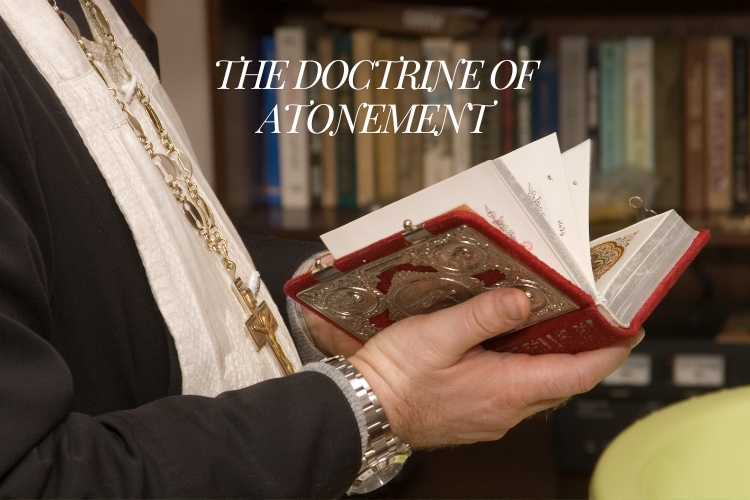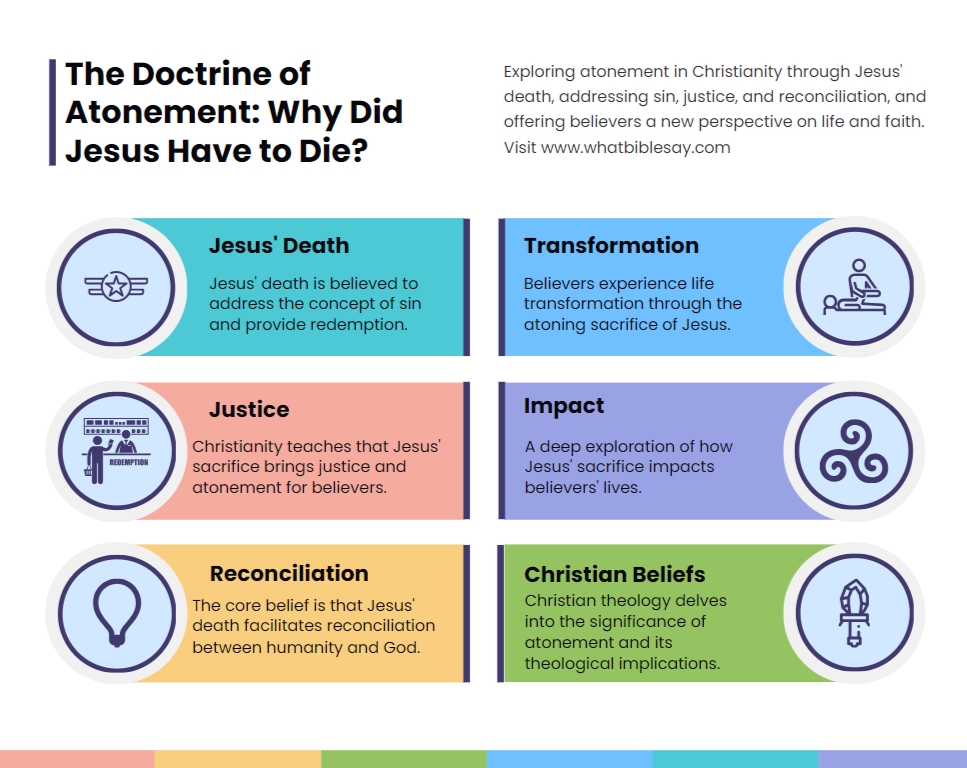The doctrine of atonement stands as a cornerstone of Christian theology, addressing one of the most fundamental questions in the faith: Why did Jesus Christ have to die?
This profound inquiry delves into the heart of Christianity’s understanding of salvation, sin, and the relationship between humanity and God. In this comprehensive exploration, we’ll unpack the complexities of atonement, examine various theological perspectives, and seek to understand the profound significance of Jesus’ sacrifice.
1. The Biblical Foundation of Atonement
Old Testament Roots
The concept of atonement finds its roots in the Old Testament, where it is closely tied to the Jewish sacrificial system. Key elements include:
- The Day of Atonement (Yom Kippur)
- Animal sacrifices for sin
- The role of blood in purification rituals
These practices laid the groundwork for the Christian understanding of atonement, establishing the principle that sin requires a sacrificial offering to restore the relationship between God and humanity.
New Testament Fulfillment
The New Testament presents Jesus as the ultimate fulfillment of the Old Testament sacrificial system. Key passages include:
- John 1:29 – “Behold, the Lamb of God who takes away the sin of the world!”
- Hebrews 9:22 – “Without the shedding of blood there is no forgiveness.”
- Romans 5:8 – “But God demonstrates his love for us in this: While we were still sinners, Christ died for us.”
These verses highlight the central role of Jesus’ death in the Christian understanding of salvation and atonement.
2. Theories of Atonement: Understanding Different Perspectives
Throughout Christian history, theologians have developed various theories to explain the mechanics and significance of atonement. While these theories often overlap, they each emphasize different aspects of Christ’s work. Let’s examine some of the most prominent theories:
1. Substitutionary Atonement Theory
This widely held view posits that Jesus died as a substitute for sinners. Key points include:
- Jesus bore the punishment that humanity deserved
- His death satisfies God’s justice
- Believers are credited with Christ’s righteousness
2. Moral Influence Theory
This perspective emphasizes the transformative power of Christ’s example:
- Jesus’ life and death demonstrate God’s love
- This demonstration inspires moral change in believers
- Salvation comes through following Christ’s example
3. Christus Victor Theory
This ancient view focuses on Christ’s victory over evil powers:
- Jesus’ death and resurrection defeat Satan, sin, and death
- Humanity is liberated from bondage to these forces
- Salvation is seen as a cosmic victory
4. Ransom Theory
This early church theory presents Christ’s death as a ransom payment:
- Humanity is held captive by Satan or evil powers
- Jesus’ death serves as a ransom to free humanity
- There’s debate over to whom the ransom is paid (God or Satan)
5. Recapitulation Theory
Developed by Irenaeus, this theory sees Christ as the new Adam:
- Jesus retraces the steps of human life without sin
- His obedience reverses Adam’s disobedience
- Salvation involves humanity being “recapitulated” in Christ
3. Comparing Atonement Theories
To better understand these theories, let’s compare them in a table format:
| Theory | Central Idea | Key Proponents | Biblical Support |
|---|---|---|---|
| Substitutionary | Jesus dies in our place | Calvin, Luther | Isaiah 53:5, 2 Cor 5:21 |
| Moral Influence | Jesus inspires moral change | Abelard, Socinus | 1 Peter 2:21 |
| Christus Victor | Jesus defeats evil powers | Early Church Fathers | Colossians 2:15 |
| Ransom | Jesus pays ransom for humanity | Origen, Gregory of Nyssa | Mark 10:45 |
| Recapitulation | Jesus relives human life without sin | Irenaeus | Romans 5:12-21 |
4. The Necessity of Jesus’ Death: Addressing the Central Question
Having explored various theories, we return to our central question: Why did Jesus have to die? Several key factors contribute to the Christian understanding of this necessity:
1. The Nature of Sin
- Sin is seen as a serious offense against a holy God
- It creates a separation between humanity and God
- The consequences of sin are spiritual death and eternal separation from God
2. God’s Justice and Love
- God’s justice requires that sin be punished
- God’s love seeks to reconcile humanity to Himself
- Jesus’ death satisfies both justice and love
3. The Inadequacy of Human Efforts
- Human beings are incapable of atoning for their own sins
- Good works are insufficient to bridge the gap between God and humanity
- A perfect sacrifice is required
4. The Fulfillment of Prophecy
- Old Testament prophecies pointed to a suffering Messiah
- Jesus saw his death as a fulfillment of these prophecies
- His death gives meaning and coherence to the biblical narrative
5. The Impact of Atonement: Transforming Lives and Communities
The doctrine of atonement is not merely an abstract theological concept; it has profound implications for individual believers and the Christian community as a whole:
Personal Transformation
- Forgiveness of sins and reconciliation with God
- Freedom from guilt and shame
- A new identity as children of God
Ethical Implications
- Motivation for moral living out of gratitude
- Emphasis on forgiveness and reconciliation in human relationships
- A call to sacrificial love and service to others
Community Formation
- The church as a community of the redeemed
- Shared practices (e.g., communion) that remember and celebrate the atonement
- A mission to share the message of reconciliation with the world
6. Challenges and Criticisms: Engaging with Difficult Questions
While the doctrine of atonement is central to Christian theology, it has faced various challenges and criticisms:
Ethical Concerns
- Questions about the justice of punishing an innocent person
- Concerns about divine child abuse or cosmic child sacrifice
- Debates over the nature of God’s wrath and love
Logical Challenges
- How can one person’s death atone for the sins of many?
- Why couldn’t God simply forgive without requiring a sacrifice?
- How does Jesus’ death 2000 years ago affect people today?
Cultural Relevance
- Difficulty in relating sacrificial concepts to modern audiences
- Challenges in explaining substitutionary ideas in non-Western contexts
- Tensions with contemporary views on justice and punishment
Conclusion, The Enduring Significance of the Atonement
The doctrine of atonement remains a central and profound aspect of Christian theology, addressing the fundamental human need for reconciliation with God. While various theories attempt to explain its mechanics, the core message remains: through Jesus’ death, God has acted decisively to address the problem of sin and to restore humanity to the right relationship with Himself.
As we’ve explored, this doctrine has far-reaching implications for personal faith, ethical living, and community formation. It continues to inspire believers to lives of gratitude, service, and love, while also prompting ongoing theological reflection and debate.
Ultimately, the question “Why did Jesus have to die?” leads us to contemplate the depths of God’s love, the seriousness of sin, and the extraordinary lengths to which God would go to reconcile humanity to Himself. It is a doctrine that continues to challenge, inspire, and transform lives, inviting each person to consider its implications for their relationship with God.





